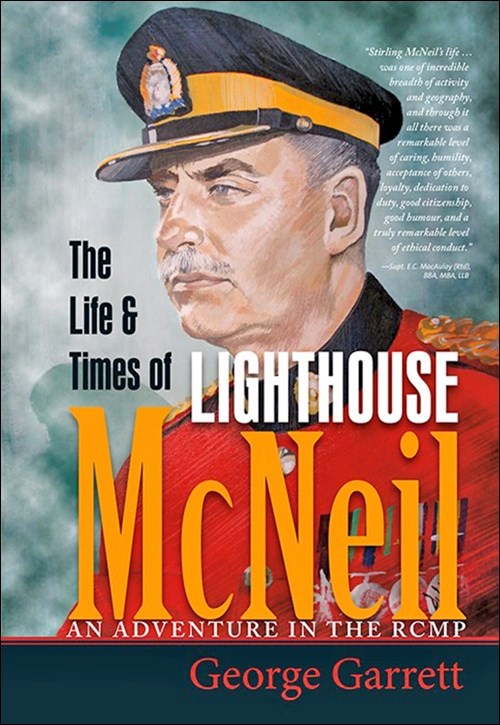By George Garrett
Published by Your Nickel’s Worth Publishing
$19.95 ISBN 978-1-927756-65-2
The legendary traditions of the Royal Canadian Mounted Police are based on individual members who excelled. In The Life & Times of Lighthouse McNeil: An Adventure in the RCMP , George Garrett chronicles the exploits of one such legendary member – Alexander Stirling McNeil. Born in Winnipeg in 1908, McNeil joined the RCMP in 1931, taking his training at “Depot” Division in Regina. By the time he retired in 1966, he had served in more than 30 detachments across Canada and became a legend in his time.
He earned his nickname “Lighthouse McNeil” in 1931 while playing with the Regina Roughriders, forerunner of the Saskatchewan Roughriders. Standing at six feet, four inches, he made an easily visible receiver. Returning to the huddle after one particular play in which the quarterback hadn’t thrown to him, he protested, “Why didn’t you throw the ball to me? I’m like a ruddy lighthouse out there!”
McNeil was involved in several significant events in Saskatchewan’s history, such as quelling a coal miners’ strike in Estevan in 1933, and helping track down Albert Johnson, the Mad Trapper of Rat River.
In the course of his career, McNeil met several prominent personalities, including Wop May, a First World War ace who was nearly shot down by the Red Baron, and Grey Owl, whom he called “a scoundrel.” McNeil arrested a drunken Grey Owl one morning when he was chasing the camp cook with a meat cleaver.
When the RCMP formed an aviation section in 1937, McNeil became part of it. He was on a flying mission when Canada declared war on Germany. He immediately radioed in to join the Royal Canadian Air Force, spending much of his military career doing intelligence and security work. After returning to the RCMP, he was appointed officer in command of the Musical Ride.
Garrett demonstrates that McNeil was a strict, no-nonsense disciplinarian. One of the problems he faced while in Prince Edward Island was the high number of fatalities caused by speeding and drunk drivers. McNeil ordered zero tolerance for violations. Within a year there were no traffic fatalities on the island.
McNeil was also incorruptible. Garrett cites several examples of him standing up to temptation.
For instance, when the premier of Prince Edward Island asked him not to enforce the Liquor Act on election day, McNeil curtly informed him it was the law of the island and would be strictly enforced.
Garrett quotes excerpts from McNeil’s memoirs, allowing readers to hear him speak in his own words. This helps bring to life the man behind the legend. Garrett also quotes recollections from McNeil’s wife and two children, as well as testimonials and reminiscences from other members of the force, for the same effect.
The RCMP has created many legends throughout its existence. Thanks to Garrett’s The Life & Times of Lighthouse McNeil, the legend of “Lighthouse” McNeil lives on.
This book is available at your local bookstore or from www.skbooks.com.




